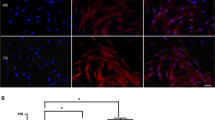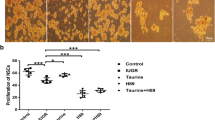Abstract
The aim of the present study was to determine if the excitatory amino acid homocysteine (Hcy) alters ERK signaling and cell proliferation in fetal neural stem cells (NSCs) in vitro. NSCs were isolated from fetal rats and grown in serum-free suspension medium. The cells were identified as NSCs by their expression of immunoreactive Sox2. NSCs were assigned to one of four treatment groups: vehicle control, low-dose Hcy group (Hcy-L, medium contained 30 μmol/L Hcy), middle-dose Hcy group (Hcy-M, 100 μmol/L Hcy) and high-dose Hcy group (Hcy-H, 300 μmol/L Hcy). Cell proliferation was evaluated by 3-(4,5-dimethylthiazol-2-yl)-2,5-diphenyltetrazolium bromide assay. Protein expression levels of ERK1/2 and phosphorylated ERK1/2 were detected by Western blot. The effects of Hcy on NSC death, including apoptosis, were assessed by using flow cytometry and trypan blue exclusion. The results showed that NSCs grew as neurospheres in the serum-free medium. Hcy decreased ERK1/2 protein phosphorylation and NSC proliferation, but it did not induce cell death or apoptosis within the concentration from 30 to 300 μmol/L. The above results are consistent with the hypothesis that Hcy decreases fetal NSC proliferation by inhibiting ERK signaling.






Similar content being viewed by others
References
Seshadri, S., Beiser, A., Selhub, J., Jacques, P. F., Rosenberg, I. H., D’Agostino, R. B., et al. (2002). Plasma homocysteine as a risk factor for dementia and Alzheimer’s disease. New England Journal of Medicine, 346, 476–483.
Lipton, S. A., Kim, W. K., Choi, Y. B., Kumar, S., D’Emilia, D. M., Rayudu, P. V., et al. (1997). Neurotoxicity associated with dual actions of homocysteine at the N-methyl-D-aspartate receptor. Proceedings of the National Academy of Sciences, 94, 5923–5928.
Kruman, I. I., Culmsee, C., Chan, S. L., Kruman, Y., Guo, Z., Penix, L., et al. (2000). Homocysteine elicits a DNA damage response in neurons that promotes apoptosis and hypersensitivity to excitotoxicity. Journal of Neuroscience, 20, 6920–6926.
Boot, M. J., RgPM, Steegers.-Theunissen., Poelmann, R. E., Iperen, L. V., Lindemans, J., & Gittenberger-de Groot, A. C. (2003). Folic acid and homocysteine affect neural crest and neuroepithelial cell outgrowth and differentiation in vitro. Developmental Dynamics, 227, 301–308.
Mwakikunga, A. M., Clubine, A. L., & Wiens, D. J. (2011). Homocysteine and cardiac neural crest cell cytoskeletal proteins in the chick embryo. International J Biol, 3, 43–56.
Duan, W., Ladenheim, B., Cutler, R. G., Kruman, I. I., Cadet, J. L., & Mattson, M. P. (2002). Dietary folate deficiency and elevated homocysteine levels endanger dopaminergic neurons in models of Parkinson’s disease. Journal of Neurochemistry, 80, 101–110.
Kruman, I. I., Kumaravel, T. S., Lohani, A., Pedersen, W. A., Cutler, R. G., Kruman, Y., et al. (2002). Folic acid deficiency and homocysteine impair DNA repair in hippocampal neurons and sensitize them to amyloid toxicity in experimental models of Alzheimer’s disease. Journal of Neuroscience, 22, 1752–1762.
Zhang, X. M., Liu, H., Cong, G. X., Tian, Z. H., Ren, D. L., Wilson, J. X., et al. (2008). Effects of folate on Notch signaling and cell proliferation in neural stem cells of neonatal rats in vitro. Journal of Nutritional Science and Vitaminology, 54, 353–356.
Zhang, X. M., Huang, G. W., Tian, Z. H., Ren, D. L., & Wilson, J. X. (2009). Folate stimulates ERK1/2 phosphorylation and cell proliferation in fetal neural stem cells. Nutritional Neuroscience, 12, 226–232.
Zhang, X. M., Huang, G. W., Tian, Z. H., Ren, D. L., & Wilson, J. X. (2009). Folate deficiency induces neural stem cell apoptosis by increasing homocysteine in vitro. Journal of Clinical Biochemistry and Nutrition, 45, 14–19.
Rabaneda, L. G., Carrasco, M., Lopez-Toledano, M. A., & Murillo-Carretero, M. (2008). Homocysteine inhibits proliferation of neuronal precursors in the mouse adult brain by impairing the basic fibroblast growth factor signaling cascade and reducing extracellular regulated kinase 1/2-dependent cyclin E expression. FASEB Journal, 22, 3823–3835.
Shetty, A. K., & Turner, D. A. (1995). Enhanced cell survival in fetal hippocampal suspension transplants grafted to adult rat hippocampus following kainate lesions: A three-dimensional graft reconstruction study. Neuroscience, 67, 561–582.
Komitova, M., & Eriksson, P. S. (2004). Sox-2 is expressed by neural progenitors and astroglia in the adult rat brain. Neuroscience Letters, 369, 24–27.
Refsum, H., Ueland, P. M., Nygard, O., & Vollset, S. E. (1998). Homocysteine and cardiovascular disease. Annual Review of Medicine, 49, 31–62.
Hirohisa, M., Atsushi, Watana., Hiroyasu, A., Kayo, A., Chigumi, O., Yasuo, T., et al. (2010). Homocysteine, another risk factor for alzheimer disease, impairs apolipoprotein E3 function. The Journal of Biological Chemistry, 285, 38382–38388.
Louis, E. D., Schupf, N., Tang, M. X., Marder, K., & Luchsinger, J. A. (2007). Mild Parkinsonian signs and plasma homocysteine concentration in community-dwelling elderly individuals. Archives of Neurology, 64, 1646–1651.
Liu, H., Huang, G. W., Zhang, X. M., Ren, D. L., & Wilson, J. X. (2010). Folic acid supplementation stimulates Notch signaling and cell proliferation in embryonic neural stem cells. Journal of Clinical Biochemistry and Nutrition, 47, 174–180.
Junttila, M. R., Li, S. P., & Westermarck, J. (2008). Phosphatase-mediated crosstalk between MAPK signaling pathways in the regulation of cell survival. FASEB Journal, 22, 954–965.
Stanciu, M., & DeFranco, D. B. (2002). Prolonged nuclear retention of activated extracellular signal-regulated protein kinase promotes cell death generated by oxidative toxicityor proteasome inhibition in a neuronal cell line. Journal of Biological Chemistry, 277, 4010–4017.
Poddar, R., & Paul, S. (2009). Homocysteine–NMDA receptor-mediated activation of extracellular signal-regulated kinase leads to neuronal cell death. Journal of Neurochemistry, 110, 1095–1106.
Moshal, K. S., Sen, U., Tyagi, N., Henderson, B., Steed, M., Ovechkin, A. V., et al. (2006). Regulation of homocysteine-induced MMP-9 by ERK1/2 pathway. American Journal of Physiology. Cell Physiology, 290, C883–C891.
Acknowledgments
This project was supported by the National Natural Science Foundation of China (No. 81072289 and 30901192).
Author information
Authors and Affiliations
Corresponding author
Rights and permissions
About this article
Cite this article
Yan, H., Zhang, X., Luo, S. et al. Effects of Homocysteine on ERK Signaling and Cell Proliferation in Fetal Neural Stem Cells In Vitro. Cell Biochem Biophys 66, 131–137 (2013). https://doi.org/10.1007/s12013-012-9461-z
Published:
Issue Date:
DOI: https://doi.org/10.1007/s12013-012-9461-z




